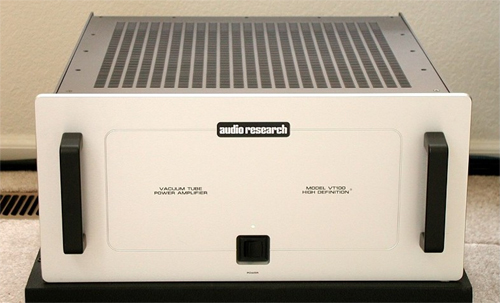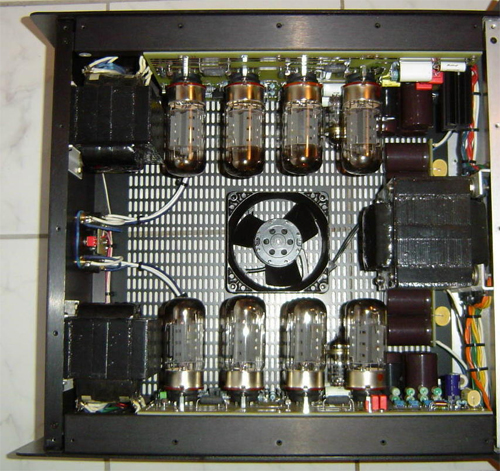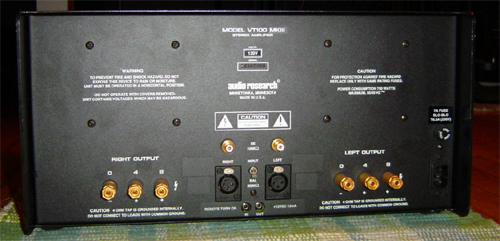You are reading the older HTML site
Positive Feedback ISSUE
14
july/august 2004
audio research
VT100MKIII amplifier
as reviewed by Jeff Parks

|
JEFF PARKS' SYSTEM
LOUDSPEAKERS
ELECTRONICS
SOURCES
CABLES
ACCESSORIES
|
Audio Research has been a high-end audio industry leader in amplifier design since its inception in 1970. If it were not for William Zane Johnson's heroic efforts to revive tube-based amplification devices when everyone else was using transistors, who knows where we would be today? A lot has changed since the "second coming" of tubes and the early days of solid state. Although the sonic gap between tube and solid state amplifiers is now smaller than ever, with both becoming more and more neutral and thus truer to the music, differences still exist.
Why do we love tubes? Tube components are a pain in the butt compared to solid-state devices. You have to regularly bias tube amps, and though this is not difficult, it is a hassle. Tubes can blow up (though they rarely do so) when they have surpassed their useful life. Tube amplifiers can also produce immense amounts of heat, especially those with high-powered output tubes like KT88s or 6550s, so unless you live in Minnesota, your sound room is going to get warm. Maybe that's why William Zane Johnson became a tube guy—he was just trying to keep his home warm while listening to music during those cold Minnesota winters. (Okay, maybe not.) Again, why do we love our tube amplifiers when modern solid-state amplifiers are more and more "tube like" in sound? Tube amplifiers just seem to get the music right, with all of the emotion and that special feeling of live sound that we long for in our sound rooms. In my opinion, solid-state amplifiers can't do this, although some of them come very close at times.
Audio Research has made some classic products that are still highly sought after on the used market. These include the Classic 60, the VT130SE, and the VT150SE. To observe how popular these amplifiers are, go to any website where high-audio components are bought and sold, and see how long one of these amplifiers lasts. They are usually sucked up within days of being listed. The VT100 has been in the ARC line since 1996, so it too is becoming something of a classic. Is the third-generation, MKIII version worthy of attention?
The original VT100 turned many heads with its robust bass performance, deep soundstaging, excellent imaging, and dynamics that drew the listener closer to the live music reference. The VT100 continues to receive "trickle down" technology from its bigger sibling, the VTM200, and each version of the VT100 has taken the amplifier to another level of performance. The changes to the VT100 since its inception in spring 1996 include:
VT100MKII (Spring 1998)
-
Installation of InfiniCaps in many parts of the amplifier's circuitry. This improved midbass response, solving one of the weaknesses of the original VT-100, a lack of midbass clarity.
-
Installation of an internal cooling fan, thus increasing tube life.
-
Use of proprietary damping rings on the 6922 input stage tubes, which helped lower the amp's noise floor.
-
Replacement of the captive power cord with a detachable cord. Users could now choose a power cord of their liking.
-
Changing the power supply energy storage from 270 joules to 540 joules, resulting in the highest energy-storage-to-wattage ratio in the ARC line. The VT100 could now boogie with the best of them. The change made the biggest difference in the amp's bass performance and in its ability to handle dynamic musical demands with ease.
VT100MKIII (Fall 2001)
-
Addition of a balanced/single-ended switch on the back panel, thus eliminating the need for shorting links in the XLR connectors.
-
Addition of a dual in/out 12V power on/off trigger, which links the VT100 MkIII to any current Audio Research preamp for remote use.
-
Upgrading of the line fuse to 7amps to allow the amplifier to handle musical dynamics with greater ease.
-
Addition of a "soft start" feature that preserves the amplifier's power circuitry by allowing the amplifier to power up gradually before operation.
-
Installation of JFETS in the input stage for ultra low noise, followed by a 6H30 tube in the driver gain stage, then a capacitor-coupled 6H30 follower which in turn drives two matched pairs of 6550 tubes. This is again to lower the noise floor of the VT100 while at the same time extending tube life.

What is this Russian supertube, the 6H30, and why did ARC choose to use it in the VT100MKIII instead of the tried-and-true 6922? Is the 6H30 better? In a word, yes! The 6H30 was brought to the United States by Victor Khomenko of Balanced Audio Technology. As almost everyone knows, the U.S. had ceased using tubes in military gear in favor of transistors by the early 70s while the Russians did not, largely because they believed that tubes were more reliable. It is said that 6H30s are tough enough to survive radiation effect a nuclear attack, so I guess if the U.S. is ever attacked, we may die, but our tube amps will keep ticking along.
Mr. Khomenko fell in love with the 6H30 because it measured significantly better than the 6922. The 6H30 was also more reliable—a major concern for manufacturers, since repairing products reduces profits with an estimated service life of over 10,000 hours this should no longer be an issue. For the consumer, the more important issue is that the 6H30 is better than the 6922 in soundstaging, imaging, and dynamics.
Mr. Khomenko bought every last 6H30 tube in existence, to ensure that he would have enough tubes for his products for a long time to come. Observing the newfound popularity of the 6H30, Reflector decided to put it back into production. The 6H30 is now readily available, and is being used by several manufacturers other than ARC, including Cary and Tenor. Since manufacturers have to base their products upon current, not past technology, it is no wonder that the 6H30 is being used in many of today's tube-based products.
Before I go any further, I think it is important to tell you how I acquired my VT100MKIII review sample. At the beginning of 2004, I decided that it was time for some additional upgrades to my reference Counterpoint monoblock hybrid amplifiers. Like many audiophiles, I am always seeking opportunities to squeeze better sound out of my rig. I spoke to the designer of the Counterpoints, who convinced me that there were a couple of things he could do to improve them. Because the amps had served me well for the previous four years, I went for it.
Unfortunately, this meant that I could not listen to music except through my car stereo, which just doesn't cut it. When the time frame for the upgrade went from two weeks to six due to complications, I could stand it no longer. My wife told me that I was beginning to change emotionally after about two weeks without being able to hear "real" music in my sound room. I now understand why so many audiophiles have two or three of everything—it is for those audio emergencies. I was beginning to think that my wife was right, and that I was morphing into a moody, short-tempered, impatient beast. Fortunately, a local retailer was more than willing to accommodate my needs, especially since, more often than not, I buy the gear I take home. Before I knew it, I had a new, 250-watt-per-channel solid-state amplifier under my arm (all right, I had to use both hands), and was taking it home for audition.
After trying that amp and two or three others with ho-hum results, I noticed the VT100MKIII in the dealer's showroom. Because it was the only one he had, he was reluctant at first to let me take it home for a personal evaluation. In time, I talked him into letting me take it home through my dogged persistence. To tell you the truth, at $6500, the amp cost more than I could afford at the time, though as all audiophiles know, if there's a will, there's a way. Since I was happy with the Counterpoint amps, I was more curious about the MKIII than seeking to purchase it. Knowing its stellar reputation, I had to give it a shot.
Right from the beginning, it was love at first audition. I was awestruck. Never had my rig sounded so big, dynamic, and REAL as it did with the VT100MKIII. There seemed to be a synergy going on between the MKIII and my old (though upgraded and modified) ARC SP-15 preamp, or maybe the MKIII is THAT GOOD. This is one of the most dynamic and neutral amplifiers, of any kind, that had graced my sound room in a very long time or ever for that matter. Thus, so impressed with the amplifier, I felt compelled to review it.
The VT100's basic design is not new—it is a straightforward push-pull pentode amplifier. It is ARC's "take" on this classic design that, I think, sets the company's products apart from those of its competitors. It is not any ONE thing that ARC does in order to create the VT100MKIII's sound, or in my opinion a lack of added sound or coloration. Rather it is a series of well thought out design procedures and applications that results in the MKIII's final sonic signature which in my opinion is one of the more neutral articulate and detailed tube designs being offered today. One thing that contributes to this amplifier's sound is its output transformers. The transformers used in the MK III are of an ultra-wide-bandwidth, proprietary design that allows the amplifier to reproduce sound well above and below the usual 20 Hz to 20 kHz. These transformers are partially responsible for the MKIII's great bass and extended high-frequency response, beyond what most of us expect from a tube-based design. Another thing that sets the MKIII apart is the output stage, a partial cathode-coupling design in which part of the audio signal goes directly to the output terminals, and the balance of the signal is driven in ultra linear mode and directed to the output transformers. ARC calls this "enriched" class AB operation. This piece in the ARC "puzzle" results in more dynamic, defined, and clear sound that is truer to the musical source.
Many people believe that what makes a tube amplifier sound like a tube amplifier is coloration, and that the lush sound and magical midrange so many of us love (plus the tubby bass we must live with) is a direct result of the use of tubes. ARC states that this is not necessarily the case. Rather, "tube sound" is a result of the parts used, the design of an amplifier, and how it is voiced, that creates the amplifier's sonic signature. ARC' seeks to design amplifiers that are highly musical—definitely at tube trait—but dynamic, with deep bass and extended highs—not usually a tube trait.
Another part of the ARC puzzle is the company's use of negative feedback. ARC uses negative feedback where part of the output signal is feed back through the amplifier to particular section of the amplifier. This "negative" (backward) feedback is compared to what is being fed the amplifier at input. If there is any difference between the two signals, the VT100MKIII corrects it, resulting in a more linear, less "colored" replica of the original signal, but at greater amplitude. According to ARC, it is the proper, limited use of negative feedback that helps give the MKIII the sound that they are looking for—one that is true to the input.
How does the VT100MKIII sound? Like music. Never in my life have I heard an amplifier sound so realistic. With the MKIII, I frequently lose myself in a musical performance, forgetting that I am listening to a studio recording and not a live event. The VT100MKIII gets it right. Its outstanding pace, rhythm, and dynamic slam renders instruments almost "dead on." An example of this is "Wishing Well," on Michael Ruff (Sheffield Lab CD-35). The MKIII gets the rhythm and pace of this close-miked rock recording correct, from the beginning of the song to the end. All of the instruments and vocals blend perfectly, revealing emotion without any hint of congestion, from the snap and pop of the snare drum to the pounding bass drum that hits you in the chest, to the driving bass guitar that you feel and hear all around you, to the four-part backup harmonies so crystal clear that you can pick out the individual voices, to the three-piece horn section that is handled with such precision and accuracy. It is uncanny how fast this amplifier responds to the music. It is almost, dare I say, solid-state-like in speed.
It is the VT100MKIII's unique speed that, in my opinion, explains why it gets the attack and decay of instruments correct, all the while preserving the musicality of its tube circuit. About midway through "Wishing Well," Michael Ruff performs a one-minute piano solo. The MKIII gets the piano right, including all of its internal resonances and the natural attack and decay of the strings as Ruff goes up and down the keyboard. The three-dimensionality is downright spooky.
Another great strength of the VT100MKIII is its ability to throw a huge soundstage that has great depth and a huge sense of space around the instruments and vocal performers. The amp creates the illusion of the performers being right there in the room. On many recordings, it sounds as if my meager, 13' x 16' sound room is much larger. The soundstage presentation is very believable, with all of the instruments in their proper locations.
On the newly remastered CD of Fleetwood Mac's Tusk (Warner Brothers 8122-73883-2), there is a new, almost nine-minute version of Stevie Nicks' song "Sara" that is so intimate that it is almost worth the price of admission. The song begins with Nicks huskily vocalizing, "I wanna be a star… I don't wanna be a cleaning lady," a reference to her employment prior to being a rock star. The VT100MKIII placed the performers in a huge soundstage. Each voice and instrument had its individual space within the soundstage. If it were not for Nicks' overuse of echo (something she usually insists upon), this recording would be almost perfect. Then again, having some echo on her voice did contribute to its haunting, seductive quality. Continuing on, I could hear the unique snap and pop of Mick Fleetwood's snare drum, along with the quiet sound of his brushes scratching its surface, almost like the sound of leaves and branches waving in the wind on a cold winter evening. This added to the seductive, dreamlike quality of the song. The background harmonies, led by Christie McVie, had a wonderful sense of air and ease, conveying a feeling like that of sirens singing.
I know this review has been a love fest so smitten was I regarding this amplifier, like all things the VT100MKIII is not perfect—though close. Being hypercritical (it's my job you know) I do have couple of concerns. One, the reproduction of bass around 40 Hz and below. There is a little bloat in this area, which can take something away from the amplifier's midbass clarity and impact. Criticisms aside please bear in mind, the MKIII's bass reproduction is still among the best of any of the tube amplifier that have graced my sound room to date. Two, some listeners (though not this one) might also criticize the MKIII for its upper-end reproduction. While it is crystal clear and highly musical, it may be a little too much for those who prefer that lush sound usually heard from tube amps.
Did ARC accomplish its goal of producing the most musically accurate and dynamic push-pull 6550-based pentode amplifier? I would have to say "Yes!" While the VT100 may not win over those who love lush tube sound, I am sure that it will appeal to those who are looking for a musical yet accurate and neutral amplifier, with enough dynamic slam to toss you right out of the room if need be. Is the ARC VT100MKIII worth its $6500 price of admission? I must think so, since I bought the amp I have been describing. Is it right for you? That is a question you will have to answer after careful consideration. For me, it was a no-brainer. Jeff Parks

Specifications
Power output: 100 watts per
channel continuous from 20Hz to 20kHz. Approximate power at clipping is 120 watts.
THD: 1kHz total harmonic
distortion (typically .3% at 100 watts and below, .03% at 1 watt).
Power bandwidth: 12Hz to 60kHz
(-3dB points at 1 watt)
Frequency response: 1hZ to 80khZ
(-3dB at 1 watt)
Input sensitivity: 1.7V RMS
(balanced or SE) for rated output (24.3 dB gain balanced into 8 ohms)
Input impedance: 200k ohms
balanced, 100 ohms single-ended
Output taps: 8 ohms, 4 ohms.
Overall negative feedback: 15dB
Slew rate: 8 volts/microsecond
Rise time: 4 microseconds
Hum & noise: less than 0.2mV RMS
103dB below rated output (IHF weighted, input shorted)
Power supply energy:
approximately 540 joules
Power requirements: 105-125 AC
60Hz (210-250 VAC 50 Hz); 650 watts at rated output, 800 watts maximum, 440
watts at idle
Tubes required: (4) matched pair
6550C; (4) 6H30
Dimensions: 19" W x 8.75" H x
19.5" D; handles extend 1.5" forward
Weight: 66 lbs.; 83 lbs.
shipping
VT100MKIII amplifier
Retail: $6500
Audio Research
web address: www.audioresearch.com
